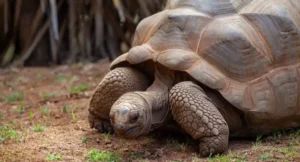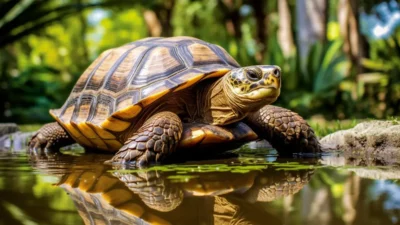Do tortoises have teeth? It’s a seemingly straightforward question that unravels a fascinating journey into the unique anatomy and dietary habits of these ancient creatures. Often revered for their slow and steady demeanor, tortoises hold a plethora of secrets within their shells, and the presence (or absence) of teeth is a captivating aspect to explore.
Let’s delve into the intriguing world of tortoises, dissecting their anatomy, feeding behaviors, and the surprising revelations about their dental structure. Whether you’re an enthusiast curious about these gentle reptiles or simply intrigued by nature’s mysteries, the answer might just surprise you. So, do tortoises have teeth? Let’s uncover the truth behind this intriguing query.
Do tortoise have teeth?

Tortoises generally do not have teeth in the traditional sense like mammals do. Instead, they have a beak or a tough, sharp-edged mouth that helps them bite and cut through vegetation. The structure of their mouth is adapted for the type of food they eat, which is primarily plant material.
While tortoises lack teeth, they have a powerful jaw and use a combination of beak and tongue movements to break down and consume their food. Their diet typically consists of various plant materials such as grasses, leaves, and fruits. The absence of teeth is one of the features that distinguishes them from many other types of reptiles and mammals.
Types of teeth found in tortoises
Tortoises, like many other reptiles, have a specific dental structure adapted to their feeding habits. The types of teeth found in tortoises are:
- Chisel-shaped beaks: Tortoises have a beak with a chisel-like structure at the front of their mouths. This beak is used for nipping off vegetation, such as leaves and grass.
- Tomium: The cutting edge of the beak is called the tomium. It is sharp and helps in shearing through plant material.
- Toothless jaw: Unlike mammals, tortoises do not have teeth in the traditional sense. Instead, they have a bony ridge in their mouth called a “beak,” which serves a similar purpose for cutting and tearing vegetation.
- Herbivorous dentition: Tortoises are herbivores, and their dental structure is adapted to grinding plant material. Their jaws are designed to crush and grind fibrous plants, and their beaks are suited for cutting and shearing through tough vegetation.
It’s important to note that tortoises do not have continuously growing teeth like some other animals. Instead, their beaks and jaws wear down naturally through feeding activities. Proper nutrition and a diet that mimic their natural habitat are crucial for maintaining the health of a tortoise’s beak and jaw structure.
Features of Tortoise Teeth
Tortoises are reptiles known for their distinctive features, and their teeth play a crucial role in their feeding habits. Here are some features of tortoise teeth:
- Beak-like Structure: Tortoises have a beak-like structure rather than traditional teeth. The upper and lower jaws are covered by a tough, horny beak made of keratin, the same substance found in human fingernails and hair.
- Herbivorous Diet: Tortoises are primarily herbivores, and their beak is adapted for cutting and grinding plant material. The shape of the beak can vary slightly among different tortoise species, depending on their specific dietary preferences.
- Lack of Teeth in Some Species: While some tortoise species have a well-developed beak, others may have a reduced or almost non-existent one. In these cases, the tortoises may rely more on a specialized tongue and jaw muscles to manipulate and process their food.
- No Incisors or Canines: Unlike mammals, tortoises do not have incisors or canine teeth. Their beak is a single, continuous structure used for biting and grinding.
- Worn Down with Age: Tortoise beaks can wear down with age due to the constant grinding against plant material. Regular wear helps maintain the beak’s effectiveness in processing food. In some cases, captive tortoises may require access to materials like cuttlebone or mineral blocks to aid in beak maintenance.
- Adaptation to Diet: The structure of a tortoise’s beak is adapted to its specific diet. For example, species that consume tough grasses may have a more robust and serrated beak, while those that primarily eat softer vegetation may have a smoother beak.
It’s important to note that the features of tortoise teeth, or lack thereof, are closely tied to their evolutionary adaptations and dietary preferences. Proper care, including providing a well-balanced diet and opportunities for natural wear, is essential for maintaining the health of a tortoise’s beak-like structure.
Functions of Tortoise Teeth
Tortoises do not have traditional teeth like mammals; instead, they have beak-like structures adapted to their herbivorous diets. The functions of these beak-like structures in tortoises include:
- Feeding: The primary function of a tortoise’s beak is to assist in feeding. It is adapted to bite, cut, and grind plant material. Tortoises are herbivores, and their beaks are designed to efficiently process a variety of vegetation, such as grasses, leaves, flowers, and fruits.
- Dietary Adaptations: The specific structure of a tortoise’s beak can vary among species, reflecting their dietary preferences and the types of vegetation available in their natural habitats. Some tortoises have serrated beaks for cutting through tougher plant materials, while others may have smoother beaks suited for softer vegetation.
- Manipulating Food: The beak serves as a tool for manipulating and grasping food. Tortoises use their beaks to tear leaves, bite through plant stems, and grasp onto various types of vegetation.
- Worn Down with Age: As tortoises age, their beaks naturally wear down through the constant grinding against plant material. This process helps maintain the effectiveness of the beak for feeding. In the wild, tortoises may also use rocks or other abrasive surfaces to aid in beak wear.
- No Incisors or Canines: Unlike mammals, tortoises lack incisors and canine teeth. Instead, their entire jaw is covered by a tough beak, providing a continuous cutting and grinding surface.
- Defense: While the primary function of a tortoise’s beak is related to feeding, in some species, the beak may also play a role in defense. Tortoises can retract their limbs and head into their shells, and the beak helps protect the vulnerable head and neck when retracted.
It’s important for tortoise owners to provide a well-balanced and appropriate diet to ensure the health of their pets.
Additionally, offering opportunities for natural wear through access to a variety of vegetation and, if necessary, providing materials for beak maintenance (such as cuttlebone) can contribute to the overall well-being of the animal. Regular veterinary check-ups are also essential for monitoring the health of a tortoise’s oral structures.
Care and Health of Tortoise Teeth

While tortoises don’t have traditional teeth, they do have a beak-like structure that requires proper care to maintain their overall health. Here are some guidelines for the care and health of tortoise teeth (beak):
- Diet:
- Provide a well-balanced, species-appropriate diet. Different tortoise species have varying dietary requirements, so it’s crucial to research and understand the specific needs of your tortoise.
- Offer a mix of leafy greens, vegetables, and, if suitable for the species, some fruits. Avoid feeding high-protein or high-fat foods, as these can lead to health issues.
- Nutritional Supplements:
- Ensure that your tortoise receives the necessary vitamins and minerals. Some species may benefit from calcium supplements, especially if they are not exposed to natural sunlight regularly.
- Natural Wear:
- Encourage natural wear of the beak by providing a variety of vegetation with different textures. This helps prevent overgrowth and ensures that the beak remains functional.
- If possible, provide access to outdoor enclosures where tortoises can graze on natural plants. Exposure to natural substrates and terrain can aid in natural wear.
- Beak Maintenance:
- Some tortoises may benefit from supplemental materials for beak maintenance. Cuttlebone, mineral blocks, or even rocks can be provided for the tortoise to rub its beak against, aiding in natural wear.
- Regular veterinary check-ups are important to monitor the health of the beak and address any issues promptly.
- Hydration:
- Ensure your tortoise has access to clean, fresh water at all times. Proper hydration is essential for overall health, including the health of the beak.
- Avoid Overgrowth:
- Regularly monitor the length and condition of the beak. If you notice overgrowth or abnormalities, consult with a reptile veterinarian.
- Some tortoises may require occasional beak trimming, which should be performed by a veterinarian experienced in treating reptiles.
- Environmental Conditions:
- Maintain proper environmental conditions, including temperature and humidity, according to the specific needs of your tortoise species. A well-regulated environment contributes to the overall health of the tortoise.
- Regular Vet Check-ups:
- Schedule regular veterinary check-ups to monitor your tortoise’s overall health, including the condition of its beak.
Remember that the specific care requirements may vary among different tortoise species, so it’s essential to research and understand the needs of your particular tortoise. If you have any concerns about your tortoise’s health or beak condition, consult with a qualified reptile veterinarian for advice and assistance.
Signs of Dental Issues in Tortoises

Tortoises, although they don’t have traditional teeth, can experience dental issues related to their beak-like structures. Monitoring your tortoise for signs of dental problems is crucial for maintaining its overall health.
Here are some signs that may indicate dental issues in tortoises:
- Overgrown Beak:
- If the beak becomes excessively long or misshapen, it may indicate a problem. Overgrown beaks can interfere with the tortoise’s ability to eat properly.
- Difficulty Eating:
- Noticeable changes in eating behavior, such as reluctance to eat, dropping food, or difficulty grasping and chewing, may be indicative of dental problems.
- Weight Loss:
- Dental issues can lead to reduced food intake, resulting in weight loss. Monitor your tortoise’s weight regularly and consult a veterinarian if you notice significant changes.
- Drooling or Excessive Salivation:
- Excessive drooling or salivation may indicate pain or discomfort associated with dental problems.
- Changes in Behavior:
- Unusual behavior, such as lethargy, increased aggression, or signs of distress, can be linked to dental issues causing discomfort.
- Facial Swelling:
- Swelling around the face or jaw area may suggest an infection or other dental problem.
- Discharge or Fluid from the Mouth:
- Any discharge or unusual fluid coming from the mouth, including blood, should be investigated promptly.
- Changes in Shell Growth:
- Dental problems can sometimes affect a tortoise’s ability to obtain proper nutrition, potentially impacting shell growth. Abnormalities in the shell should be assessed by a veterinarian.
- Inability to Close the Mouth Properly:
- If the tortoise is unable to close its mouth fully or exhibits difficulty in doing so, it could be a sign of dental issues.
- Oral Lesions or Sores:
- Ulcers, lesions, or sores in the oral cavity may indicate dental problems or other health issues.
If you observe any of these signs, it’s crucial to seek veterinary attention promptly. A veterinarian with experience in reptile care can perform a thorough examination, including an assessment of the beak and oral cavity.
Treatment may involve beak trimming, addressing any underlying health issues, and providing appropriate dietary adjustments. Regular veterinary check-ups and proactive monitoring of your tortoise’s health are essential for preventing and addressing potential dental problems.
How owners can care for a tortoise’s oral health?
Caring for a tortoise’s oral health involves a combination of providing the right diet, creating an appropriate environment, monitoring their beak, and seeking veterinary care when necessary.
Here are some tips for owners to care for their tortoise’s oral health:
- Provide a Balanced Diet:
-
- Offer a well-balanced, species-appropriate diet rich in leafy greens, vegetables, and, if suitable for the species, some fruits. Different tortoise species have specific dietary requirements, so research and tailor the diet accordingly.
- Avoid high-protein or high-fat foods, as they can lead to health issues.
- Encourage Natural Wear:
-
- Offer a variety of vegetation with different textures to encourage natural wear of the beak. Outdoor enclosures with access to natural plants can contribute to natural beak maintenance.
- Supplement with Cuttlebone or Mineral Blocks:
-
- Provide cuttlebone or mineral blocks for your tortoise to rub its beak against. This helps in natural wear and provides additional minerals, including calcium.
- Maintain Proper Hydration:
-
- Ensure your tortoise has access to clean, fresh water at all times. Proper hydration is crucial for overall health, including the health of the beak.
- Regularly Monitor Beak Length:
-
- Regularly check the length and condition of your tortoise’s beak. If you notice overgrowth, abnormalities, or signs of wear unevenness, consult with a reptile veterinarian.
- Environmental Conditions:
-
- Maintain appropriate environmental conditions, including temperature and humidity, according to the specific needs of your tortoise species. A well-regulated environment contributes to overall health.
- Provide Proper Lighting:
-
- Ensure your tortoise receives adequate natural sunlight or UVB lighting, as this is essential for calcium metabolism. UVB light aids in the synthesis of vitamin D, which is crucial for calcium absorption.
- Regular Veterinary Check-ups:
-
- Schedule regular veterinary check-ups to monitor your tortoise’s overall health, including the condition of its beak. A veterinarian with experience in reptile care can perform a thorough examination.
- Seek Professional Beak Trimming When Needed:
-
- If your tortoise’s beak becomes overgrown or develops abnormalities, consult with a qualified reptile veterinarian for professional beak trimming. Do not attempt to trim the beak yourself unless you have experience and the necessary tools.
- Observe Behavior Changes:
-
- Be attentive to any changes in your tortoise’s behavior, eating habits, or overall activity level. Unusual behaviors may be early signs of health issues.
By adopting these practices, tortoise owners can contribute to the overall oral health and well-being of their pets. Regular attention, a proper diet, and prompt veterinary care are key elements in maintaining a healthy and happy tortoise.
Conclusion
You can get the answers to the question do tortoise have teeth on this page. Tortoises do not have traditional teeth. Instead, they possess a beak-like structure made of keratin, similar to a bird’s beak. This adaptation suits their herbivorous diet, allowing them to bite, cut, and grind plant material.
Owners should focus on providing a well-balanced diet, encouraging natural wear of the beak, and seeking veterinary care to ensure the overall oral health of their tortoise.

